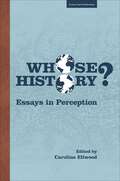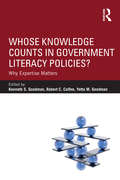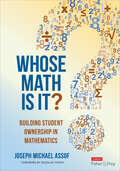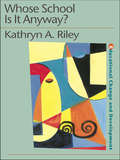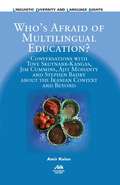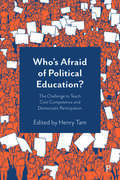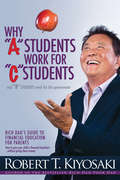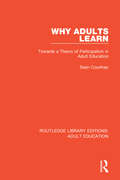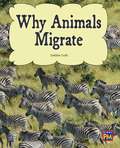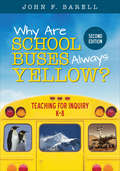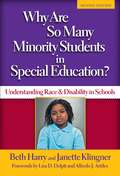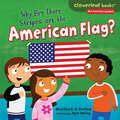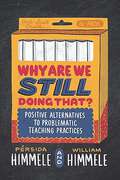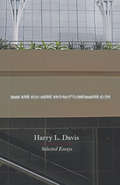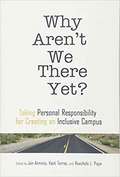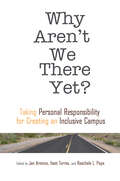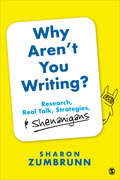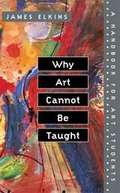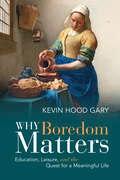- Table View
- List View
Whose History: Essays in Perception
by Caroline EllwoodToday, more than ever, students and teachers should be better able to address questions of perspective with more original sources at their fingertips. Whose History? raises and addresses important questions about how history is perceived, not only through aspects of historiography but by teachers deciding how and what to teach in this modern world. A wide range of respected contributors with a vast experience in education cover topics such as: Coming to terms with the past: Germany's changing view of the Second World War; Dangerous interpretations in post conflict history teaching; and Is the past such a foreign country? Rediscovering history as a way to understanding the micropolitics of the present. Contributors include: Dinos Aristidou; Richard Caston; Dr Richard Caffyn; Dr Rebecca Conway; Malcolm Davis; Dr Caroline Ellwood; Terry Haywood; Dr Walther Hetzer; Jack Higginson; Dr Siva Kumari; Roger Moorhouse; Professor Olukoya Ogen; Dr Malcolm Pritchard; Dr Rauni Rasanen; Paul Regan
Whose History: Essays in Perception
by Caroline EllwoodToday, more than ever, students and teachers should be better able to address questions of perspective with more original sources at their fingertips. Whose History? raises and addresses important questions about how history is perceived, not only through aspects of historiography but by teachers deciding how and what to teach in this modern world. A wide range of respected contributors with a vast experience in education cover topics such as: Coming to terms with the past: Germany's changing view of the Second World War; Dangerous interpretations in post conflict history teaching; and Is the past such a foreign country? Rediscovering history as a way to understanding the micropolitics of the present. Contributors include: Dinos Aristidou; Richard Caston; Dr Richard Caffyn; Dr Rebecca Conway; Malcolm Davis; Dr Caroline Ellwood; Terry Haywood; Dr Walther Hetzer; Jack Higginson; Dr Siva Kumari; Roger Moorhouse; Professor Olukoya Ogen; Dr Malcolm Pritchard; Dr Rauni Rasanen; Paul Regan
Whose Knowledge Counts in Government Literacy Policies?: Why Expertise Matters
by Robert C. Calfee Kenneth S. Goodman Yetta M. GoodmanAccountability, in the form of standardized test scores, is built into many government literacy policies, with severe consequences for schools and districts that fail to meet ever-increasing performance levels. The key question this book addresses is whose knowledge is considered in framing government literacy policies? The intent is to raise awareness of the degree to which expertise is being ignored on a worldwide level and pseudo-science is becoming the basis for literacy policies and laws. The authors, all leading researchers from the U.S., U.K., Scotland, France, and Germany, have a wide range of views but share in common a deep concern about the lack of respect for knowledge among policy makers. Each author comes to the common subject of this volume from the vantage point of his or her major interests, ranging from an exposition of what should be the best knowledge utilized in an aspect of literacy education policy, to how political decisions are impacting literacy policy, to laying out the history of events in their own country. Collectively they offer a critical analysis of the condition of literacy education past and present and suggest alternative courses of action for the future.
Whose Math Is It?: Building Student Ownership in Mathematics
by Joseph AssofFoster Confidence and Ownership in Every Math Student When it comes to math, does it feel like some students embrace problem-solving with agency and ownership while others are confused—or simply along for the ride? How do educators bridge that divide to develop competence, confidence, and ownership in every student? The answers lie in establishing clear and effective measures for success. Steeped in the principles of success criteria, Whose Math Is It? provides educators with everything they need to create a classroom environment where students feel empowered to step up and take the lead. Divided into two parts, this must-read guide first defines what success looks like for math students, then provides the research-based best practices teachers can use to help students take control of their learning. Learn how to: Define and establish effective success criteria in a mathematics classroom Implement a variety of strategies to support student ownership and success Develop class-wide social norms specific to math Promote metacognition through self-regulated learning, self-assessment, and feedback Reinforce student ownership through structured peer interactions and collaboration Whose Math Is It? is an essential resource for K-12 math teachers who want to empower their students to actively own their mathematics learning. By emphasizing the importance of success criteria, promoting self-regulated learning, and developing math-specific social norms, this book provides practical strategies for creating an environment where when asked, "Whose math is it?" every student can emphatically respond: My math!
Whose Math Is It?: Building Student Ownership in Mathematics
by Joseph AssofFoster Confidence and Ownership in Every Math Student When it comes to math, does it feel like some students embrace problem-solving with agency and ownership while others are confused—or simply along for the ride? How do educators bridge that divide to develop competence, confidence, and ownership in every student? The answers lie in establishing clear and effective measures for success. Steeped in the principles of success criteria, Whose Math Is It? provides educators with everything they need to create a classroom environment where students feel empowered to step up and take the lead. Divided into two parts, this must-read guide first defines what success looks like for math students, then provides the research-based best practices teachers can use to help students take control of their learning. Learn how to: Define and establish effective success criteria in a mathematics classroom Implement a variety of strategies to support student ownership and success Develop class-wide social norms specific to math Promote metacognition through self-regulated learning, self-assessment, and feedback Reinforce student ownership through structured peer interactions and collaboration Whose Math Is It? is an essential resource for K-12 math teachers who want to empower their students to actively own their mathematics learning. By emphasizing the importance of success criteria, promoting self-regulated learning, and developing math-specific social norms, this book provides practical strategies for creating an environment where when asked, "Whose math is it?" every student can emphatically respond: My math!
Whose School is it Anyway?: Power and politics
by Kathryn RileyIn the 1970s, two events in particular, the William Tyndale School and James Callaghan's Ruskin speech, generated extensive media coverage and political activity and became 'watersheds' along the path to political and educational reform. This has shaped the system of school and governments in the 1990s. This book revisits Tyndale and Ruskin and examines their legacy. Drawing on contemporary accounts of a number of key individuals who were involved in those watershed events, it recasts their stories in the light of current changes in education. The book explores the extent to which both these events shifted assumptions about education and provided the rationale for policy changes. It argues that fundamental questions need to be asked about the nature of the reform agenda and in particular, the balance of power. It also places the reform agenda within an international context.
Who’s Afraid of Multilingual Education?: Conversations with Tove Skutnabb-Kangas, Jim Cummins, Ajit Mohanty and Stephen Bahry about the Iranian Context and Beyond
by Amir KalanMore than 70 languages are spoken in contemporary Iran, yet all governmental correspondence and educational textbooks must be written in Farsi. To date, the Iranian mother tongue debate has remained far from the international scholarly exchanges of ideas about multilingual education. This book bridges that gap using interviews with four prominent academic experts in linguistic human rights, mother tongue education and bilingual and multilingual education. The author examines the arguments for rejecting multilingual education in Iran, and the four interviewees counter those arguments with evidence that mother tongue-based education has resulted in positive outcomes for the speakers of non-dominant language groups and the country itself. It is hoped that this book will engage an international audience with the debate in Iran and show how multilingual education could benefit the country.
Who’s Afraid of Political Education?: The Challenge to Teach Civic Competence and Democratic Participation
by Henry TamDemocracy should enable citizens to play an informed role in determining how power is exercised for their common wellbeing, but this only works if people have the understanding, skills and confidence to engage effectively in public affairs. Otherwise, any voting system can be subverted to serve the interests of propagandists and demagogues. This book brings together leading experts on learning for democracy to explore why and how the gap in civic competence should be bridged. Drawing on research findings and case examples from the UK, the US and elsewhere, it will set out why change is necessary, what could be taught differently to ensure effective political engagement, and how a lasting impact in improving citizens’ learning for democratic participation can be made.
Why "A" Students Work for "C" Students and Why "B" Students Work for the Government
by Robert T. KiyosakiKiyosaki expands on his belief that the school system was created to churn out 'Es' / Employees... those "A Students" who read well, memorize well and test well... and not the creative thinkers, visionaries and dreamers -entrepreneurs-in-the-making... those "C Students who grow up to be the innovators and creators of new ideas, businesses, applications and products.The book urges parents not to be obsessed with their kids' "letter grades" ("good grades" might only mean they or the student themselves were successful in jamming a square peg into a round hole...) and focus, instead, on concepts, ideas, and helping their child find their true genius, their special gift. The path they can pursue with a love and true passion.Robert showcases success stories of "C Students" who grew up to be phenomenal successes - and HIRED those "A Students"(attorneys, accountants, and other school-smart specialists) to work in their businesses... while the more average students, "B Students," often find themselves in government-type jobs...Not surprisingly, Kiyosaki will coin his own definitions of what "A," "B," and "C" stand for as he gives parents and their children bits of wisdom as well as insights and tools for navigating an ever-changing world... an Information Age world where the ability to change and adapt, understand relationships, and anticipate the future will shape their lives.
Why Adults Learn: Towards a Theory of Participation in Adult Education (Routledge Library Editions: Adult Education)
by Sean CourtneyOriginally published in 1992 this book looks at the phenomenon of adult education by exploring the nature of the motivation that moves people to return to school or to seek involvement inorganized learning activities. The book challenges the psychological emphasis of much research on adult learning. It concentrates on the concept of social participation and its implications for a reinterpretation of adult learning as an aspect of a person's involvement with his or her community or society.
Why Afterschool Matters
by Ingrid A. NelsonIncreasingly, educational researchers and policy-makers are finding that extracurricular programs make a major difference in the lives of disadvantaged youth, helping to reduce the infamous academic attainment gap between white students and their black and Latino peers. Yet studies of these programs typically focus on how they improve the average academic performance of their participants, paying little attention to individual variation. Why Afterschool Matters takes a different approach, closely following ten Mexican American students who attended the same extracurricular program in California, then chronicling its long-term effects on their lives, from eighth grade to early adulthood. Discovering that participation in the program was life-changing for some students, yet had only a minimal impact on others, sociologist Ingrid A. Nelson investigates the factors behind these very different outcomes. Her research reveals that while afterschool initiatives are important, they are only one component in a complex network of school, family, community, and peer interactions that influence the educational achievement of disadvantaged students. Through its detailed case studies of individual students, this book brings to life the challenges marginalized youth en route to college face when navigating the intersections of various home, school, and community spheres. Why Afterschool Matters may focus on a single program, but its findings have major implications for education policy nationwide.
Why Are Professors Liberal and Why Do Conservatives Care?
by Neil GrossSome observers see American academia as a bastion of leftist groupthink that indoctrinates students and silences conservative voices. Others see a protected enclave that naturally produces free-thinking, progressive intellectuals. Both views are self-serving, says Neil Gross, but neither is correct. Why Are Professors Liberal and Why Do Conservatives Care? explains how academic liberalism became a self-reproducing phenomenon, and why Americans on both the left and right should take notice. Academia employs a higher percentage of liberals than nearly any other profession. But the usual explanations-hiring bias against conservatives, correlations of liberal ideology with high intelligence-do not hold up to scrutiny. Drawing on a range of original research, statistics, and interviews, Gross argues that "political typing" plays an overlooked role in shaping academic liberalism. For historical reasons, the professoriate developed a reputation for liberal politics early in the twentieth century. As this perception spread, it exerted a self-selecting influence on bright young liberals, while deterring equally promising conservatives. Most professors' political views were formed well before they stepped behind the lectern for the first time. Why Are Professors Liberal and Why Do Conservatives Care? shows how studying the political sympathies of professors and their critics can shed light not only on academic life but also on American politics, where the modern conservative movement was built in no small part around opposition to the "liberal elite" in higher education. This divide between academic liberals and nonacademic conservatives makes accord on issues as diverse as climate change, immigration, and foreign policy more difficult.
Why Are School Buses Always Yellow?: Teaching for Inquiry, K-8 (Corwin Teaching Essentials)
by John F. BarellTurn natural curiosity into deep, lasting learnings! Inquiry is what drives us all toward new knowledge, but how do we transform children’s natural ability to notice and wonder into the full learning cycle of observing, thinking, and critically questioning? Through this new edition of the bestselling Why Are School Buses Always Yellow? you’ll find simple, yet systematic ways to develop authentic student inquiry that fosters deep learning. This new edition features: Updates based on the latest research around inquiry-based teaching Emphasis on turning inquiry into critical thinking, assessing students’ inquiry, and involving families in the inquiry process Examples for K–8 across subject areas New emphasis on critical thinking about technologies New and updated activities, checklists, templates, and implementation tools Alignment with Common Core and Next Generation Science Standards With this invaluable resource, help students transform their playful wonderings into deeper questions about content—and develop the higher-level thinking skills they need for success in school and in life. "Educators often talk about developing lifelong learners - our team has had great success using Why Are School Buses Always Yellow? to catalyze professional conversations about how we can better cultivate curiosity through an inquiry approach. I strongly recommend this [new edition] for those who are interested in unlocking the uniquely creative capacity of our youngest learners." Devin Vodicka, Superintendent Vista Unified School District, Vista, CA
Why Are School Buses Always Yellow?: Teaching for Inquiry, K-8 (Corwin Teaching Essentials)
by John F. BarellTurn natural curiosity into deep, lasting learnings! Inquiry is what drives us all toward new knowledge, but how do we transform children’s natural ability to notice and wonder into the full learning cycle of observing, thinking, and critically questioning? Through this new edition of the bestselling Why Are School Buses Always Yellow? you’ll find simple, yet systematic ways to develop authentic student inquiry that fosters deep learning. This new edition features: Updates based on the latest research around inquiry-based teaching Emphasis on turning inquiry into critical thinking, assessing students’ inquiry, and involving families in the inquiry process Examples for K–8 across subject areas New emphasis on critical thinking about technologies New and updated activities, checklists, templates, and implementation tools Alignment with Common Core and Next Generation Science Standards With this invaluable resource, help students transform their playful wonderings into deeper questions about content—and develop the higher-level thinking skills they need for success in school and in life. "Educators often talk about developing lifelong learners - our team has had great success using Why Are School Buses Always Yellow? to catalyze professional conversations about how we can better cultivate curiosity through an inquiry approach. I strongly recommend this [new edition] for those who are interested in unlocking the uniquely creative capacity of our youngest learners." Devin Vodicka, Superintendent Vista Unified School District, Vista, CA
Why Are So Many Minority Students in Special Education?
by Beth Harry Janette KlingnerThe second edition of this powerful book examines the disproportionate placement of Black and Hispanic students in special education. The authors present compelling, research-based stories representing the range of experiences faced by culturally and linguistically diverse students who fall in the liminal shadow of perceived disability. They examine the children's experiences, their families' interactions with school personnel, the teachers' and schools' estimation of the children and their families, and the school climate that influences decisions about referrals to special education. Based on the authors' 4 years of ethnographic research in a large, culturally diverse school district, the book concludes with recommendations for improving educational practice, teacher training, and policy renewal.
Why Are There Stripes on the American Flag? (Cloverleaf Books (tm) -- Our American Symbols Ser.)
by Kyle Poling Martha E. RustadDo you know why the US flag has stars and stripes on it? What does the flag stand for, and why do we say the Pledge of Allegiance? Join Mr. Gomez's class as they study the flag to find out! They'll learn when the first American flag was made, what the Pledge of Allegiance means, and why we still honor the flag today.
Why Are We Still Doing That: Positive Alternatives to Problematic Teaching Practices
by Pérsida Himmele and William HimmeleThe best-selling authors of Total Participation Techniques address 16 common educational practices that undermine student learning and offer better ways to achieve the intended aims.
Why Are You Here and Not Somewhere Else: Selected Essays
by Harry L. DavisHarry L. Davis joined the faculty of the University of Chicago Booth School of Business in 1963, and he has since become one of the most influential figures in business education in the United States and abroad. He helped develop the first core leadership program of any top-rated MBA institution in the country and the Management Lab. Davis also helped Booth pioneer its first international campus in Barcelona in 1983, where he served as deputy dean for a decade. On the occasion of the fiftieth anniversary of Davis's arrival at the Booth School, Why Are You Here and Not Somewhere Else offers seven essays by Davis that offer new perspectives and contribute to a more well-rounded understanding of business education. Adapted from convocation addresses given by Davis at different points during his five-decade career, the essays encapsulate the spirit of business education at the Booth School, while at the same time providing encouraging, invaluable wisdom for those about to embark on business careers or take on leadership positions. Topics addressed range from the role of the university in the business world to the crucial role of intangible values in shaping one's career. Davis has been a formative influence on more executives and leaders than perhaps any other business educator living today, and Why Are You Here and Not Somewhere Else provides a unique and valuable perspective on how leaders in business and elsewhere can shape and define their careers in new ways.
Why Aren't We There Yet?: Taking Personal Responsibility for Creating an Inclusive Campus
by Raechele L. Pope Vasti Torres Jan ArminioDespite seeming endless debate and public attention given to the issue for several decades, those committed to creating welcoming and engaging campus environments for all students recognize that there is considerably more work to be done, and ask “Why aren’t we there yet, and when will we be done?” <p><p> While our campuses have evolved from being exclusionary and intolerant, and publicly espouse the objectives of being welcoming, accepting, affirming, and engaging, the data on admissions, retention, and graduation clearly indicate that these goals have not been achieved. <p><p> The contributors to this book seek to offer new insights to improve student affairs, emphasizing action that recognizes this is a complex and multi-faceted process, and beginning with the assertion that, without recognizing the influences of privilege and inequality, we educators cannot promote truly welcoming environments. <p><p> This book focuses on guiding individuals and groups through learning how to have difficult conversations that lead us to act to create more just campuses, and provides illustrations of multiple ways to respond to difficult situations. It advocates for engaging in fruitful dialogues regarding differing social identities including race, ethnicity, religion, gender, and sexual orientation, to lead readers through a process that advocates for justice, and for taking personal responsibility for contributing to the solution. <p><p> The book is framed around the five elements of the process of engaging in difficult conversations that not only advocate for change but also create change: self knowledge, knowledge of and experiences with others, understanding historical and institutional contexts, understanding how to change the status quo, and transformative action.
Why Aren't We There Yet?: Taking Personal Responsibility for Creating an Inclusive Campus (An ACPA Co-Publication)
by Raechele L. Pope Vasti Torres Jan ArminioCo-published with Despite seeming endless debate and public attention given to the issue for several decades, those committed to creating welcoming and engaging campus environments for all students recognize that there is considerably more work to be done, and ask “Why aren’t we there yet, and when will we be done?” While our campuses have evolved from being exclusionary and intolerant, and publicly espouse the objectives of being welcoming, accepting, affirming, and engaging, the data on admissions, retention, and graduation clearly indicate that these goals have not been achieved.The contributors to this book seek to offer new insights to improve student affairs, emphasizing action that recognizes this is a complex and multi-faceted process, and beginning with the assertion that, without recognizing the influences of privilege and inequality, we educators cannot promote truly welcoming environments. This book focuses on guiding individuals and groups through learning how to have difficult conversations that lead us to act to create more just campuses, and provides illustrations of multiple ways to respond to difficult situations. It advocates for engaging in fruitful dialogues regarding differing social identities including race, ethnicity, religion, gender, and sexual orientation, to lead readers through a process that advocates for justice, and for taking personal responsibility for contributing to the solution. The book is framed around the five elements of the process of engaging in difficult conversations that not only advocate for change but also create change: self knowledge, knowledge of and experiences with others, understanding historical and institutional contexts, understanding how to change the status quo, and transformative action.
Why Aren’t You Writing?: Research, Real Talk, Strategies, & Shenanigans
by Sharon K. ZumbrunnWrite more with less pain! Why Aren’t You Writing?: Research, Real Talk, Strategies, & Shenanigans describes research on how bright and otherwise fairly normal people lose their minds when it comes to writing, and then shows the reader how to stop being one of those people. Author Sharon Zumbrunn designed this brief text for beginning and struggling academic writers so they can understand the psychological hang-ups that can get in the way of productivity. This book intertwines social and behavioral science research and humor to offer tips and exercises to help writers overcome their hurdles. Each chapter includes a description of findings from psychological and related research on writing hurdles and personal experiences of the writing process. Within the chapters, the author provides practical strategies and resources to help writers move beyond the challenges holding them back. Why Aren′t You Writing? acknowledges how emotionally and mentally challenging it can be to be a "writer." This book helps readers to balance the hard work required for change with a bit of levity often necessary for withstanding sustained difficult thinking and meaningful change. Together, the components of this text present a systematic approach for beginning and struggling academics to become aware of what might be happening in their heads when they (don’t) write, and harness that knowledge to build a healthier and more resilient relationship with writing.
Why Aren’t You Writing?: Research, Real Talk, Strategies, & Shenanigans
by Sharon K. ZumbrunnWrite more with less pain! Why Aren’t You Writing?: Research, Real Talk, Strategies, & Shenanigans describes research on how bright and otherwise fairly normal people lose their minds when it comes to writing, and then shows the reader how to stop being one of those people. Author Sharon Zumbrunn designed this brief text for beginning and struggling academic writers so they can understand the psychological hang-ups that can get in the way of productivity. This book intertwines social and behavioral science research and humor to offer tips and exercises to help writers overcome their hurdles. Each chapter includes a description of findings from psychological and related research on writing hurdles and personal experiences of the writing process. Within the chapters, the author provides practical strategies and resources to help writers move beyond the challenges holding them back. Why Aren′t You Writing? acknowledges how emotionally and mentally challenging it can be to be a "writer." This book helps readers to balance the hard work required for change with a bit of levity often necessary for withstanding sustained difficult thinking and meaningful change. Together, the components of this text present a systematic approach for beginning and struggling academics to become aware of what might be happening in their heads when they (don’t) write, and harness that knowledge to build a healthier and more resilient relationship with writing.
Why Art Cannot Be Taught: A Handbook for Art Students
by James ElkinsIn this smart survival guide for students and teachers - the only book of its kind - James Elkins examines the curious endeavor to teach the unteachable that is generally known as college-level art instruction. This singular project is organized around a series of conflicting claims about art: Art can be taught, but nobody knows quite how. Art can be taught, but it seems as if it can't be since so few students become outstanding artists. Art cannot be taught, but it can be fostered or helped along. Art cannot be taught or even nourished, but it is possible to teach right up to the beginnings of art so that students are ready to make art the moment they graduate. Great art cannot be taught, but more run-of-the-mill art can be. Elkins traces the development (or invention) of the modern art school and considers how issues such as the question of core curriculum and the intellectual isolation of art schools affect the teaching and learning of art. art as a whole and dissects real-life critiques, highlighting presuppositions and dynamics that make them confusing and suggesting ways to make them more helpful. Elkins's no-nonsense approach clears away the assumptions about art instruction that are not borne out by classroom practice. For example, he notes that despite much talk about instilling visual acuity and teaching technique, in practice neither teachers nor students behave as if those were their principal goals. He addresses the absurdity of pretending that sexual issues are absent from life-drawing classes and questions the practice of holding up great masters and masterpieces as models for students capable of producing only mediocre art. He also discusses types of art - including art that takes time to complete and art that isn't serious - that cannot be learned in studio art classes. Why Art Cannot Be Taught is a response to Elkins's observation that we know very little about what we do in the art classroom. involved in it, while opening an intriguing window for those outside the discipline.
Why Boredom Matters: Education, Leisure, and the Quest for a Meaningful Life
by Kevin Hood GaryBoredom is an enduring problem. In response, schools often do one or both of the following: first, they endorse what novelist Walker Percy describes as a 'boredom avoidance scheme,' adopting new initiative after new initiative in the hope that boredom can be outrun altogether, or second, they compel students to accept boring situations as an inevitable part of life. Both strategies avoid serious reflection on this universal and troubling state of mind. In this book, Gary argues that schools should educate students on how to engage with boredom productively. Rather than being conditioned to avoid or blame boredom on something or someone else, students need to be given tools for dealing with their boredom. These tools provide them with internal resources that equip them to find worthwhile activities and practices to transform boredom into a more productive state of mind. This book addresses the ways students might gain these skills.
